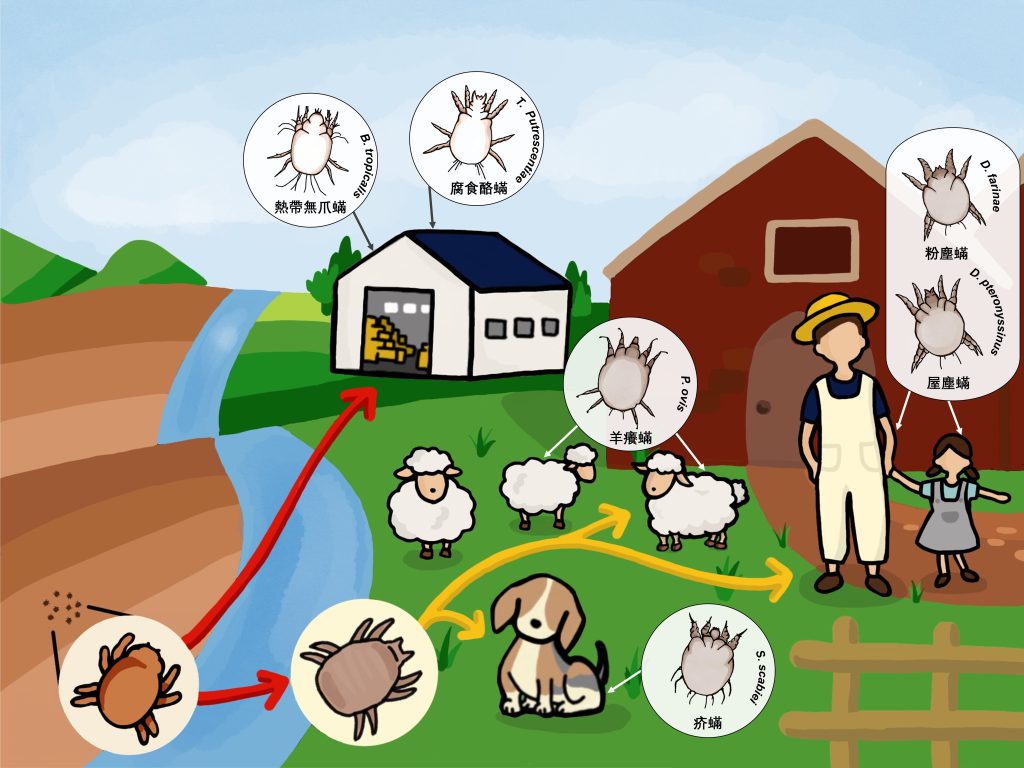CUHK
News Centre
CUHK unveils the evolutionary history of medically important mites, laying the genomics groundwork for diagnosis of and intervention in mite allergy
The medically important astigmatic mites have long been known as the major cause of human allergies. Recently, a groundbreaking study led by The Chinese University of Hong Kong (CUHK)’s Faculty of Medicine (CU Medicine) with researchers from universities in Guangzhou, Shenzhen, Wuxi, Macao, Thailand, South Korea and Singapore, has revealed their divergent evolution. The findings lay the genomics groundwork for diagnosis of and intervention in mite allergy, and have been published in Molecular Biology and Evolution, a prestigious international scientific journal.
Mites are the predominant triggers of allergy symptoms in Hong Kong
Allergic diseases are immune-system disorders characterised by IgE-mediated immunological reactions, including asthma, allergic rhinitis and atopic dermatitis. They are especially prevalent and dangerous among children, such as severe asthmatic exacerbation causing death. In Hong Kong, over 50% of the population have at least one form of allergic disease; in particular, the number of children (under 14 years old) suffering from allergies has continued to soar in recent decades. House dust mites are the predominant triggers in about 40% to 60% allergic individuals in Hong Kong.
Dr. Agnes Sze Yin LEUNG, Assistant Professor of the Department of Paediatrics at CU Medicine, remarked, “The common symptoms of mite allergy include nose itching, sneezing, nasal congestion and a cough that is worse at night. In patients who ingested mite-contaminated food, severe symptoms such as shortness of breath, swelling of the throat, dizziness or even fatal anaphylaxis can also occur.”
Astigmatic mites, comprising house dust mites, storage mites and parasitic mites (e.g. itch mites), are a group of rapidly evolving and successfully radiating small organisms. The two groups of free-living domestic species, house dust mites and storage mites, are major causes of human allergies. Relative to house dust mites, storage mites are less important in human allergies. Dr. Leung said, “Storage mites can exist in improperly stored food powders, while house dust mites can exist in household mattresses and soft toys, and scabies caused by itch mites can spread rapidly in crowded environments. Therefore, effective methods must be found to control the effects these mites can cause.”
Research team has been working diligently on mite genomics over the years
The research group led by Professor Stephen Kwok Wing TSUI, Professor of the School of Biomedical Sciences at CU Medicine, has been working diligently for over a decade on mite genomics, revealing the comparative genomics of astigmatic mites using six high-quality genomes and cracking their evolutionary history, from emergence to extreme diversification.
Dr. Angel Tsz Yau WAN, a member of the research team and former Postdoctoral Fellow of the School of Biomedical Sciences at CU Medicine, explained, “In the divergent evolution of astigmatic mites, a wide range of gene family expansions facilitated their rapid adaptation. This comparative genomics study comprehensively illustrates the evolutionary dynamics of these allergic astigmatic mites and reveals the genetic fundamentals for how these mites diverged from soil mites, rapidly evolved and quickly adapted to human household environments.”
Dr. Qing XIONG, Postdoctoral Fellow of the School of Biomedical Sciences at CU Medicine, added, “Mites and ticks were formerly considered as a monophyletic group, but we refute the monophyly and suggest that astigmatic mites are monophyletic with plant parasitic mites and soil mites, using convincing genomic evidence. We clearly depicted the whole evolutionary picture of astigmatic mites, especially involving a wide range of genomic variations. According to our estimation, the ancestral astigmatic mite branched out from soil mites about 418 million years ago (MYA), possibly developed a symbiotic lifestyle and then experienced at least two rounds of evolutionary divergence.”
The team found that in the first round of divergence (278 MYA), the ancestor of free-living storage mites split from ectoparasitic mites with limited free-living ability. The second round (212 MYA) happened in the ancestral ectoparasitic mite, in which skin-burrowing parasitic mites like itch mites developed their niche adaptation with gene loss, while the primitive house dust mite independently reversed the parasitism from its ectoparasitic ancestor through gene family expansions (145 MYA), and later became the primary cause of human allergies.
Horizontal gene transfer (HGT) is the movement of genetic information across mating barriers, such as DNA sharing between bacterial and animal genomes. “In our genomic analysis of astigmatic mites, we identified many unusual HGT genes, mainly from soil bacteria. These HGTs introduced functionally important genes and enriched their adaptation novelties, especially in detoxification and digestion. Because these HGT genes have no homologue in humans, they are suggested as perfect drug targets for the pest control of astigmatic mites,” Professor Stephen TSUI added.
The collaborative research group hopes that this pioneering comparative genomics study not only expands our knowledge of astigmatic mites and provides comprehensive genomic resources for scientific researchers in this field, but also ultimately contributes to the clinical diagnosis of and intervention in mite allergies.

A groundbreaking study led by CU Medicine has revealed the divergent evolution of astigmatic mites. The findings lay the genomics groundwork for diagnosis of and intervention in mite allergy,
From left: Dr. Angel WAN, former Postdoctoral Fellow and Prof. Stephen TSUI, Professor, both from the School of Biomedical Sciences; Dr. Agnes LEUNG, Assistant Professor from the Department of Paediatrics and Dr. Qing XIONG, Postdoctoral Fellow from the School of Biomedical Sciences, at CU Medicine.

The study by Prof. Stephen TSUI’s team has clearly depicted the whole evolutionary picture of astigmatic mites, especially involving a wide range of genomic variations and DNA sharing between bacterial and animal genomes via Horizontal Gene Transfer. These are important for the adaptation of mites in different environments.


